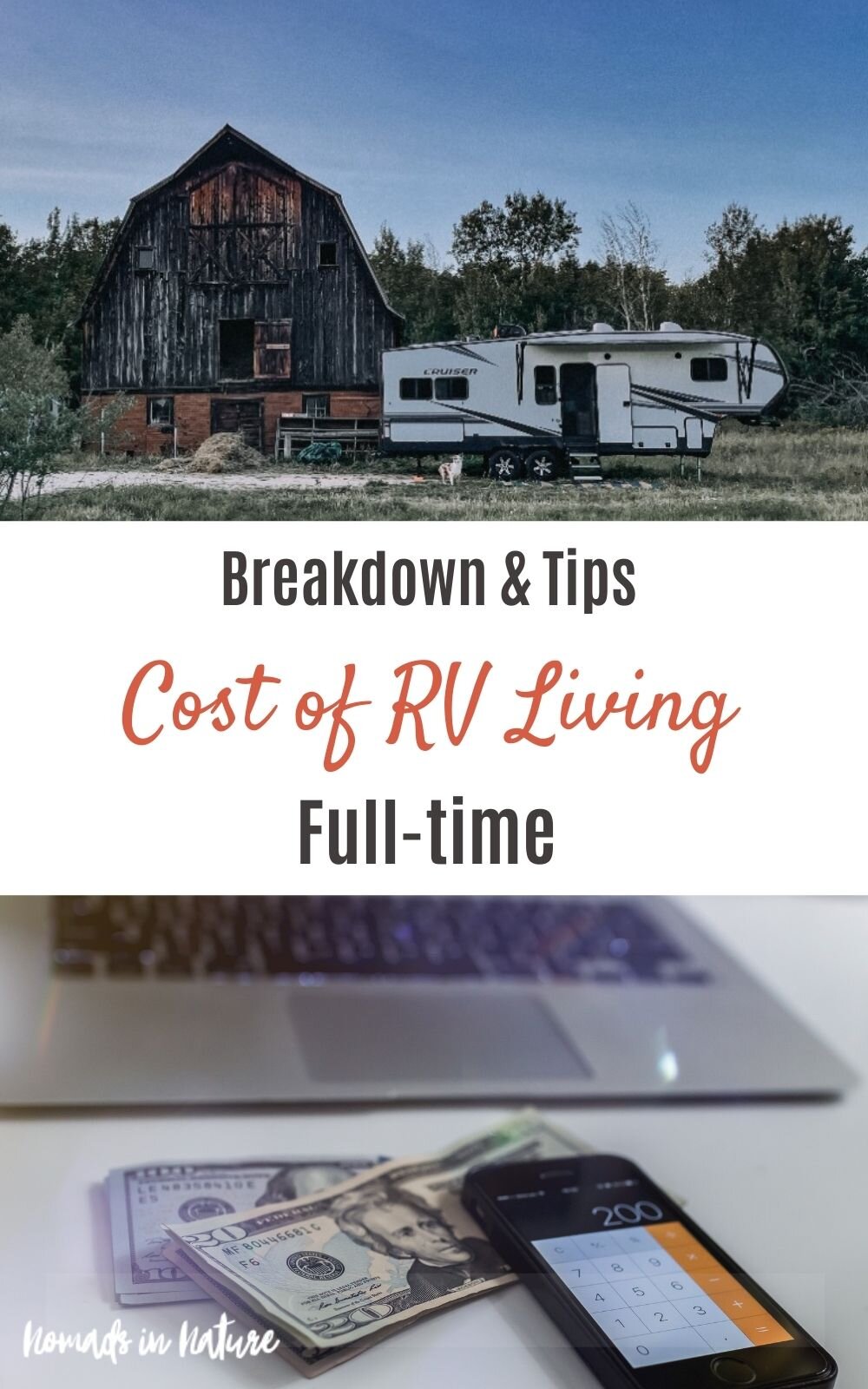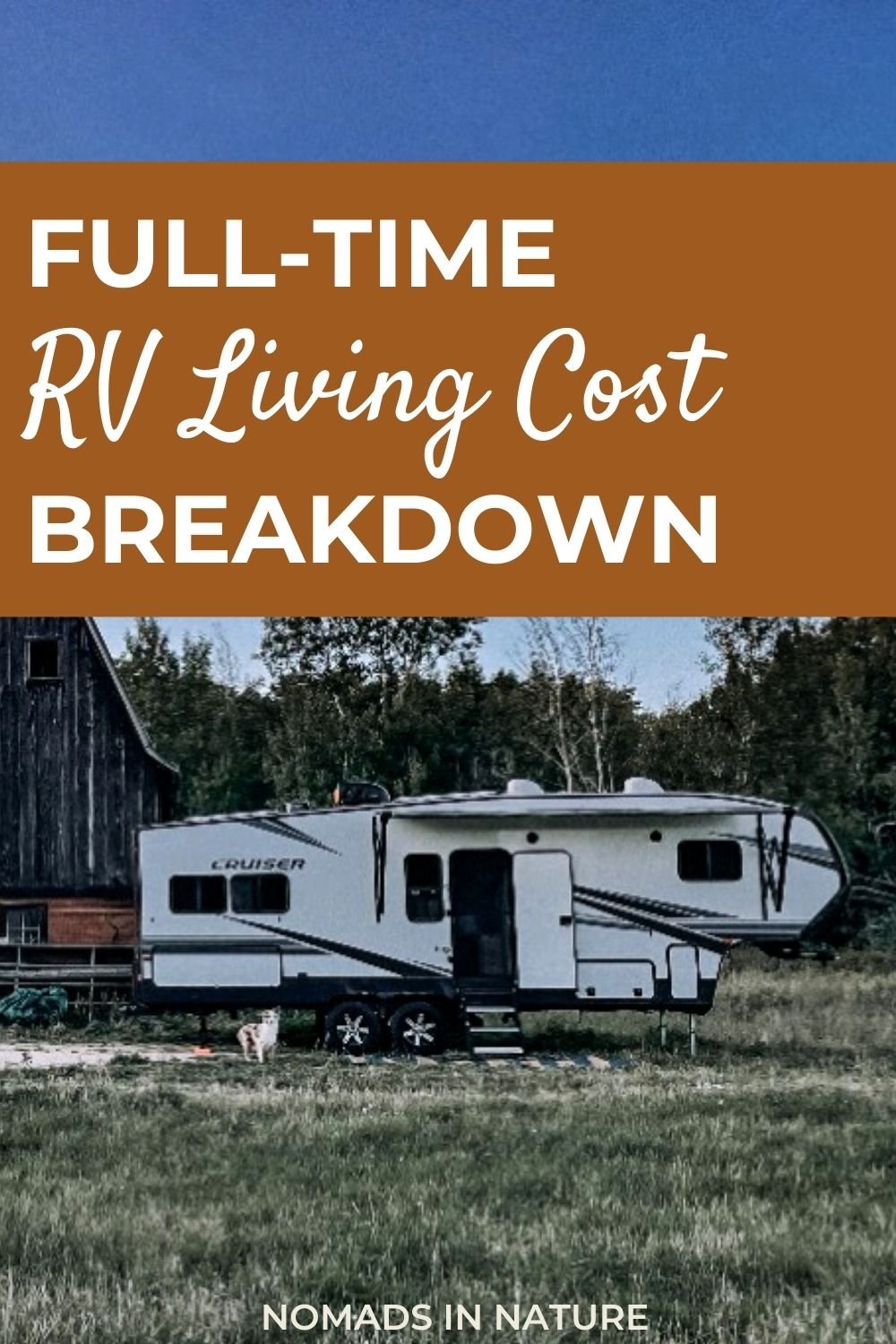Cost of Living in an RV Full Time [2025 Update]
Have you been day dreaming about living in an RV and traveling full time, but you don’t know how to make it work financially?
The cost of living in an RV full time will be very different for each person or family.
Some people choose to live in an RV simply to save money. Other people, like us, move to an RV full time to have the freedom to travel.
I will walk you through the costs of living in an RV and how they can vary depending on your lifestyle.
When we moved into our RV in 2020, we did not know how much everything was going to cost. We saved up as much money as we could before hitting the road.
Since I am a CPA, before we started I made sure we had a rough budget based on our current expenses and what I could research from other full-timers, and I’ve been able to update our budget using our actual expenses while on the road.
Here is what our current budget is (for two adults) living in our RV full-time:
Use this free calculator tool to create your own budget for full time RV living.
You might notice that we don’t have a monthly payment on our truck or our RV. We paid cash for both so we wouldn’t have to pay interest. Truck and RV payments can be significant additions to your budget, so make sure you factor them in if you are financing your rig.
Overall, our cost for full-time RV living is right around the middle of the road. We travel all over the country, and we like to have fun wherever we go.
While towing the rig all over costs more in gas, we offset this cost by only staying in paid campgrounds or RV parks for ~10 nights per month.
We have seen monthly full time RV living budgets from fellow travelers as low as $1,600 and as high as $5,000.
If you really want to go minimal, you can easily live this life for around $1,000 per month by finding a free spot to park your rig for extended periods or by becoming a camp host.
Before you can know how much RV life will cost you, it is important for you to know how much your “normal” life costs you now.
Some expenses like food and student loan payments won’t change much when you move to an RV, so knowing your typical monthly expenses will save you some time.
Track your expenses for a few months to get a feel for where you spend your money.
Some expenses will end up being much more than you thought (restaurants and bars), and you will likely find areas where you can cut back and save some money.
Full Time RV Living - Main Costs
While some of your current expenses won’t change when you move to an RV, some expenses will change significantly.
You will still have major expenses like gas, insurance, and campsite fees; but their percentage of your total budget is likely to shift.
Because the cost of RV living can be very different from person to person (or family to family), make sure you consider these major expense categories to help you estimate your monthly expenses for your new lifestyle:
Gas and propane
Campsite fees
Food
RV/truck loan and maintenance
Insurance (medical, RV, vehicle)
Phone / Internet
Entertainment
Outstanding Debt/Loans
Remember that your RV travel style will take shape as you learn what you like and what you don’t like.
Some RVers hit the road expecting to travel to new places every week and, like us, quickly learn that they’d rather be in one spot for a month or two at a time.
RV lifestyle choices like these will have huge impacts on the cost of full-time RVing.
I recommend creating a few scenarios in my Full-Time RV Budget Calculator to get a feel for what your monthly expenses might be.
RV Living Cost #1: Gas and Propane
Gas and propane are often the highest expense for full time RVers. There are many factors that can impact your gas and propane expenses.
Fuel economy for your rig: This can range anywhere from ~5 mpg for gas trucks towing large rigs to 20+ for diesel Sprinter vans.
Large motorhomes often tow smaller vehicles to use around town to save on gas and make it easier to maneuver crowded areas.Distance traveled each month: You can travel as much or as little as you want in an RV. We travel a lot during the summer to see a bunch of awesome places that are covered in snow all winter.
During the winter, there aren’t as many options for RVers (who don’t love the cold); so we stay places longer and don’t tow as much.Season and weather: Not only does the season impact how much we travel, it impacts how much propane we use. We use 2-3x as much propane in the winter as in the summer because we use propane to heat our RV.
Also, shorter days mean less solar power for electric cooking devices so we end up using more propane.Gas and propane prices: Gas and propane prices vary significantly from state to state. Also, global economic and political situations can cause prices to swing in either direction. We use the GasBuddy app to check gas prices where we are and where we are going to try to save as much as we can along the way.
We have a 38-gallon tank in our truck, so saving $0.20 or $0.30 / gallon by filling up strategically can lead to significant savings.
We spend around $400-500 per month on diesel for our truck and $30-100 per month on propane to run our stove, oven, water heater, and central heating. Both of these expenses tend to be seasonal.
We spend more on diesel in the summer when we travel frequently, and we spend more on propane in the winter to heat the RV.
➔ Read next: How Much Solar Power Do I Need for My RV?
RV Living Cost #2: Campsite Fees
Campsite fees for full time RVers include the cost to stay in an RV park or campground plus any dump, water, and electric fees you pay along the way.
This expense category is one that you can pay as much or as little as you want, depending on where you set up camp.
Some people are willing to shell out a lot of cash to stay in fancy RV parks to have the creature comforts of home, while others prefer free dispersed camping.
Let’s walk through the main camping options:
RV Parks:
RV parks are the most expensive option for full time RVers. Nightly rates are normally $50-70 per night. Most RV parks give discounts for weekly stays, and some have big discounts for monthly stays.
When we stayed at our favorite RV park in Heber UT it cost $700 a month, but their nightly rate was $65.
Monthly RV park stays are a good option for people who want full hook-ups and don’t mind staying in each place for at least one month.
Some RV parks even have pools, hot tubs, and golf courses. While there can be cozy amenities, RV parks are often glorified parking lots with neighbors on both sides of you.
For us, the crowded environment is an even bigger turn-off than the high nightly rates.
National / State Park campgrounds:
Established campgrounds offer a great balance of the comforts of RV parks (many have electrical and water hook-ups) and the nature found in boondocking.
Every park is different, but most national or state park campgrounds cost $25-40 per night.
You tend to get more room between you and your neighbors than you would in an RV park, and many campgrounds have trees between sites for privacy.
One of the main benefits of camping in a state or national park is you often times you are in the heart of the action with beautiful trails, lakes, and rivers within reach. We like to stay in established campgrounds when we want to immerse ourselves in a specific park.
Boondocking:
Also known as “dispersed” or “dry camping”, boondocking refers to free camping on public land.
The most common boondocking locations are on land managed by the Bureau of Land Management (BLM), the National Forest Service, and the Department of Fish and Wildlife.
These “campgrounds” are usually primitive with no electricity, water, or bathrooms. We boondock around 75% of our nights since we have solar and 60 gallons of water that will last us 14 days at a time.
You can usually only camp on public lands for 14 days at a time, so our setup works perfectly for boondocking.
➔ Read next: Best Free Campsites in the Western US
RV Living Cost #3: Food
Food is one cost that most likely won’t change much when you make the transition to full time RV living.
You will still be feeding the same amount of people, and your diets will be mostly the same. If you like to eat out a lot, you probably will still find a way to eat out a lot.
If you live on a budget and cook all your meals from scratch, you can continue doing this in an RV.
While using your existing food budget is a great start, there are a few factors to consider that could impact your food budget in RV life:
Your cooking skills: Being a good cook can save you A LOT of money in both RV life and normal household life.
If you aren’t already practicing your cooking skills, I suggest starting now.
Traveling in an RV allows you to check out many different local cuisines. Just keep in mind that going to restaurants and breweries all the time adds up quickly.Your destinations: If you are planning to visit popular tourist destinations in remote places (i.e. Yellowstone or Olympic National Park), stock up on groceries before you get there or plan to spend a little more than normal.
Small towns don’t have big box grocery stores, and mom-and-pop convenience marts tend to have higher prices. This is especially noticeable in popular tourist spots like one of our favorites: Telluride, CO.Your rig: Every RV has different cooking and food storage capabilities. One of our top priorities when we were shopping for our RV was having a “big” kitchen and fridge. We love to cook, and we knew that we wanted to camp in remote areas for 1-2 weeks at a time.
Smaller rigs tend to make cooking and storing food more difficult. That doesn’t mean that you can’t cook all of your meals in a van kitchen, but you will need to modify some recipes and make more trips to the grocery store.
RV Living Cost #4: RV/Truck Loan and Maintenance
Out of all of the RV living costs, truck repairs and RV maintenance are the most difficult to predict.
Most months, this expense category is $0, but it jumps to $1,000+ a few times per year. We budget $200 per month for repairs and maintenance needed for our truck and RV.
On average, this comes out to about right as we spent $2,300 in our first year on the road.
I recommend that full-time RVers always have $5,000 in reserves saved for the inevitable rig breakdown.
While you don’t know when or where it will happen, repair costs are a part of RV life. You can help prevent some of the most costly repairs by staying on top of your maintenance.
Investing in a good tire pressure monitoring system and air compressor can save you a bunch of headaches on the road.
Monitor your air pressure and the condition of your tires like a hawk so you don’t end up stranded in the middle of nowhere.
Also, make sure you stay up to date with your oil changes and brake replacements for your truck or motorhome to prevent costly mechanic charges down the road.
➔ Read next: 15 Items Every New RV Must-Have
RV Living Cost #5: Insurance
Everyone has different insurance needs, so your total insurance expense will be something you need to estimate on your own.
Some people can work on the road and take advantage of an employer paying for health insurance. Other people will need to finance their insurance out of pocket. And some of us also have gambled to save by not having any insurance.
When it comes to insurance on our RV and truck, we pay $140 per month. This will vary significantly based on your state of residence, your rig, and your insurance policy.
Finding a company to insure your full time RV living can be tricky.
While our truck insurer (USAA) is incredible and affordable, they will not cover an RV if we live in it full-time, so they referred us to Progressive.
I recommend that you reach out to your current insurance agent to see if they will cover you.
As with any insurance, shop around to make sure you get the best rate for the policy you want.
RV Living Cost #6: Phone and Internet
When you live in an RV full-time, having reliable internet is very important. Most full-time RVers use Verizon or AT&T because they give you the best chance of getting service in small towns and remote locations.
Savings Tip- If you are military, both Verizon and AT&T give a monthly discount!
We have had a usable Verizon signal in almost every campsite we have stayed.
One major consideration you need to make when choosing your phone plan for full time RVing is the hotspot allowance.
Unless you are stationary at an RV park with strong WiFi (which is very rare), you will be relying on your phone’s hotspot to connect devices to the internet.
If you are working from the road and need extra hotspot data, consider getting a separate mobile hotspot device.
These are also handy because you can get one with a service provider separate from your cell phone.
We took note from other veteran full timers and use Verizon for our phones and have an AT&T mobile hotspot to make sure we have internet wherever we go.
One way to save some cash on your phone bill is to go with one of the secondary mobile providers that use the Verizon or AT&T towers, such as Visible.
Visible is getting very popular with nomads because you get access to Verizon’s huge network for as low as $25/month. The only caveat with Visible that we noticed is they do not have physical stores so it’s an online chat only for help.
Cricket is another popular secondary provider option for people wanting to use AT&T’s network.
For those of you needing the best internet reliability, and who love the remote area, you will want to look into Starlink for RVs.
➔ Read next: 30+ Amazing RV Accessories
RV Living Cost #7: Entertainment
We finally got to the fun part: Entertainment. We throw all of the expenses not covered above into this expense bucket.
Whether it is a must-have TV provider, shopping for new camping gear, or going to a concert, we lump it all into entertainment. We don’t have much storage space left in our RV, so almost all of our entertainment budget is spent on experiences.
We budget $300/month for entertainment, but we aren’t very strict with this one.
If there is something that we really want to do, we do it. We have had a few months where entertainment is over $500, and those were some of our favorite months.
While we have overspent our entertainment budget a few times, this expense category is one that we find easy to pull back on.
Fortunately for us, nature provides plenty of free entertainment.
If you buy the America the Beautiful pass for $80/year, you get access to all of the national parks plus over 2,000 other federal parks and landmarks.
Considering #RVlife…7 Questions to Ask Yourself before going Full-time
read next—
Please share this blog post!


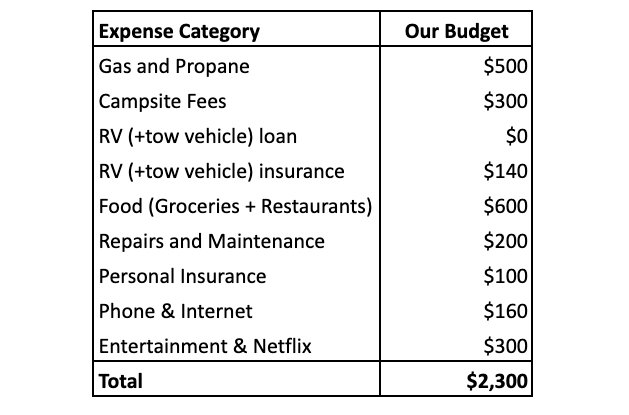






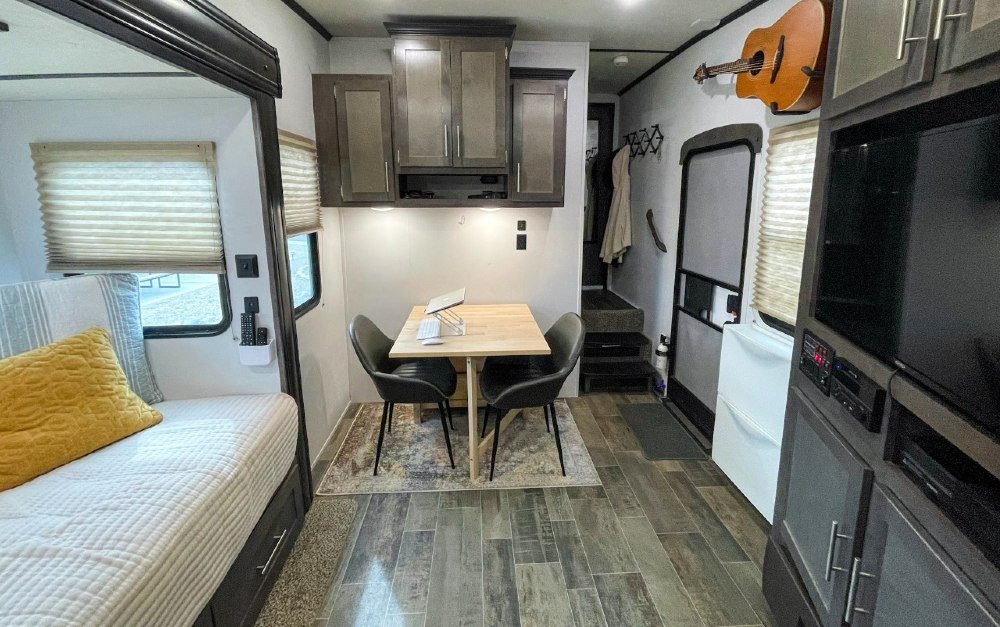

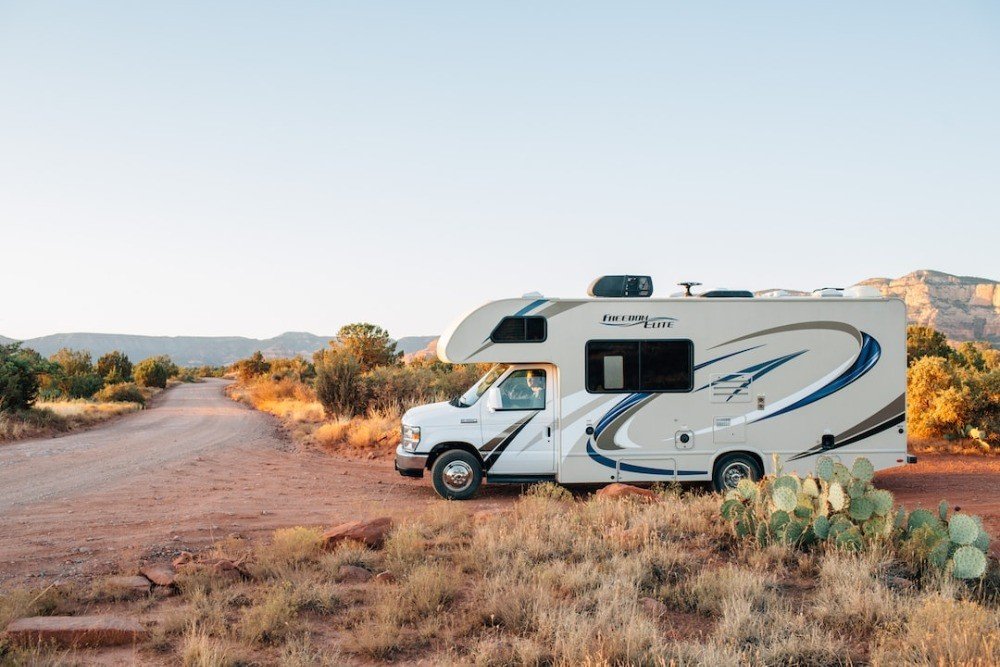
![Cost of Living in an RV Full Time [2025 Update]](https://images.squarespace-cdn.com/content/v1/5fcc02a08eda244dc49e8a8b/1669830199855-EWVB0N804TS4ZDTHWTOO/RV+Life+Cost.jpg)
